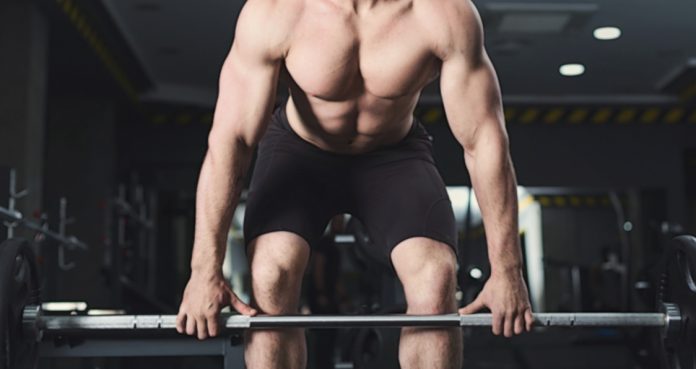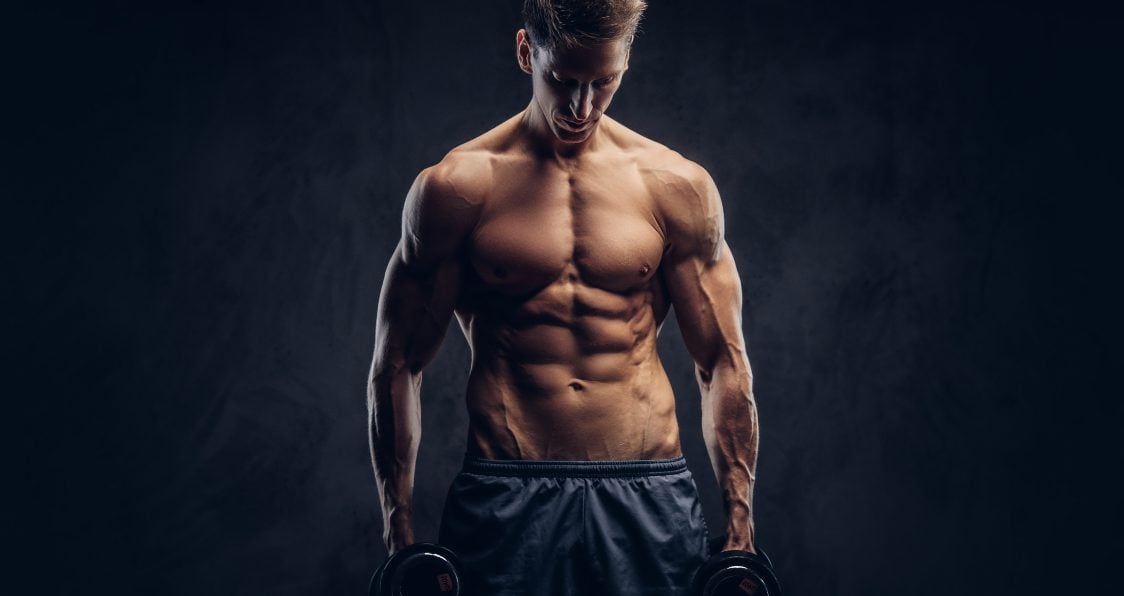
The Many Benefits of Posterior Chain Training
Strength training can be used for a multitude of reasons – to improve aesthetics, strength, performance or reduce the risk of injury.
Perhaps you’ve been having some problems with your training programs and the results just don’t quite live up to your expectations.
This article will look at the posterior chain and highlight the many benefits of regularly training it. In addition, the article will provide a fantastic posterior-chain training program for you to use.
Why It Is Vital To Train The Posterior Chain
Nowadays, people are sitting for long time periods and are generally less active than in years gone by. This can wreak havoc with our posture, alignment, and general movement.
The biggest issue that many face is commuting to work and work itself. Many individuals work in an office and therefore often seated for the best part of the day.
Being seated for many hours can lead us to forget about good posture and proper alignment which can apply a great deal of stress to our muscles and joints (1).
As a result of this stress, our bodies adapt to accommodate long periods of sitting by shortening the hip flexors and hamstrings (leg) which adversely alters pelvic tilt.
Furthermore, the shortening of the pectorals (chest) can pull the shoulders forward and consequently cause the rounding of the upper back & shoulders.
Many individuals with forward shoulders have lost the ability to fully retract and depress the shoulders.
As a result of muscles shortening, tightening and being underutilized, the joints can become less mobile and stiffer.
Many office workers display postural problems such as forward head, rounded back & shoulders, tight hamstrings & stiff hips.
Not only is this not a good look, but it can significantly reduce performance and increase the chances of experiencing an injury.
The combination of tightened muscles and muscular imbalances is dangerous and may significantly increase the chances of sustaining an injury.
In addition to this, pain can be a real issue with shoulder, back, arm, wrist, and neck pain coming out on top in a recent study (2).
Considering the role that the posterior chain plays in posture, movement, and performance, strengthening these muscles should be a top priority.

Feeding the Postural Problem
The issue with many strength training programs is that they fail to take into account postural starting points and how your work or daily habits may impact your posture.
Typically, strength & hypertrophy programs use a 1:1 push to pull ratio. Pushing exercises tend to develop the anterior chain whereas pulling exercises work the posterior chain.
When starting strength training, the majority of beginners target all the anterior chain muscles as they are most visible.
In fact, it’s not just beginners who do this – at some point, everyone will have been guilty of overdeveloping the anterior chain and neglecting the unseen posterior chain.
The problem with developing the anterior muscles more quickly than the posterior muscles is that you are simply exacerbating any postural issues that may exist (3).
Now, this is not to suggest that you should remove all anterior-focused exercises from your program, rather the overall volume should be adjusted so that more posterior chain work is performed.
While it is important to adjust the volume to increase the amount of posterior work, it must be accompanied with appropriate mobility work to maintain joint health and promote efficient movement.
As you will see in the program, there is a great emphasis on the posterior chain strength and mobility. There is a specific focus on the shoulder depressors, retractors & external rotators, the glutes & hamstrings, and core.
When you consider the role that the core plays in maintaining good posture, strengthening muscles such as the multifidus, diaphragm, erectors spinae & transverse abdominis can have a huge impact on posture (4).
Furthermore, increasing core strength can also lead to a better performance with a number of compound lifts, such as the squat, deadlift, bench, bent rows, and overhead press.

Work Considerations
If you are an individual who works in an office or spends a long portion of the day seated, look to increase your activity levels throughout the day.
If you must sit for the majority of the day, aim to adjust your seated position every hour, if possible.
As the day progresses, pay particular attention to your posture and how you are sat. Being aware of your own body position and adjusting yourself regularly can have a significant impact.
Good posture involves keeping upright by extending the spine, pushing the chest high, pulling the shoulders back & down, and keeping the core engaged (5).
Be very aware of your neck position too. It should be in a comfortable, neutral position with the head back and ever so slightly extended.
Initially doing this may feel strange, however as with learning a new exercise, the more you practice, the better you become at it to the point where it is automatic.
Ensure your desk is set up to allow you to sit with good posture. If you find that your posture is poor when seated, place a tennis ball between you and the chair to “remind” you to maintain good posture.

Posterior Chain Training Program
The following sample posterior chain program has two parts – warm-up and strength training. It has been designed to improve both posterior chain strength and movement.
Part 1: Warm-Up
As mentioned earlier, while strengthening the posterior chain muscles is crucial, it must be accompanied with appropriate mobility work.
Ensure that you complete the following 4-stage warm-up prior to commencing the strength work.
The warm-up is a key part of the session as it can help to increase range of motion, performance and reduce injury risk.
It is recommended to complete the warm-up on rest days too as performing it more regularly will improve mobility and reduce fatigue & DOMS (delayed onset muscle soreness).
1. Soft Tissue Release (i.e foam rolling)
Focus primarily on the pec minor, lats, adductors and quads. Spend some time on any muscles that are tight or sore.
2. Stretches
Stretch out the levator scapulae, pecs, subscapularis, traps, lats, hip flexors, quads, adductors, and calves.
3. Mobility Work
Use the following exercises to mobilize a number of joints:
– Cat-cow to child’s pose (spine & pelvis)
– Knee to wall drill (ankles)
– Strider exercise, a worlds greatest stretch, 90-90 hip stretch and adductor stretch (hips)
– T-spine foam roller extension and lying t-spine rotation stretch (thoracic spine)
4. Activation Exercises
Use the following muscle activation exercises and complete 1 set of 10-15 reps to adequately prep the muscles for lifting:
– Wall slides
– Band pull aparts
– Glute bridge
Part 2: Strength Training
For safe and effective exercise, good technique is vitally important. If you are unsure always consult an exercise professional.
The exercises that have been selected work posterior muscles from a variety of positions and angles in order to stimulate muscle fibers efficiently to comprehensively develop strength and size.
It’s important to remember that this is a sample program and therefore may not fit your goals or levels of experience. It can be adjusted to suit.
For optimal back and shoulder development, use a number of rowing variations that use multiple angles and positions.
Focus on hip-hinging movements along with single-leg squat variations, abduction work & bridges to effectively target the glutes.
Finally, for core development, use exercises that require the body to resist extension, rotation, and lateral rotation.

Day 1: Upper Body
| Exercise | Sets x Reps |
| 1. Chest Supported Dumbbell Row 2. Chest Supported Dumbbell Rear Delt Fly |
3 x 10-12 3 x 12-15 |
| 1. Neutral Grip Dumbbell Chest Press 2. Chest Supported W-Raise |
3 x 10-12 3 x 12-20 |
| 1. Seated Machine Alternating Row 2. Banded Y Raise (with 2-second holds) |
2 x 12-15 2 x 6-12 |
| 1. Half-Kneeling Landmine Press 2. Hollow Body Isometric Hold |
2 x 10-12 1-2 sets |
Day 2: Lower Body
| Exercise | Sets x Reps |
| Barbell Romanian Deadlift | 4 x 10-12 |
| 1. Reverse Lunges 2. Seated Band Abduction 3. Single-Leg Hip Thrust 4. Pallof Press |
3 x 10-12 3 x 15-20 3 x 8-12 2 sets |
Day 3: Upper Body
| Exercise | Sets x Reps |
| 1. Seated High Cable Row 2. Standing Band W Raise |
4 x 10-12 4 x 12-15 |
| 1. Pull-Overs 2. Prone Lower Trap Raise |
3 x 12-15 3 x 12-15 |
| 1. Alternating Seal Row 2. Push-Ups |
3 x 8-12 3 x 12-15 |
| 1. Behind the Neck Pull Aparts (with 2-second holds) 2. Long Lever Plank |
2 x 12-15 1-2 sets |
Day 4: Lower Body
| Exercise | Sets x Reps |
| Barbell Sumo Deadlift | 4 x 8-10 |
| Bulgarian Split Squat to Romanian Deadlift | 4 x 10-20 |
| 1. Feet-Elevated Banded Glute Bridge 2. Banded Dead Bug 3. Suitcase Carry |
2 x 15-20 2 x 6-12 2 x 1-1.5 mins |
Final Word
Having a strong posterior chain is highly beneficial for day-to-day activities. However, it is important that mobility is also prioritized in conjunction with all strength work.
The program outlined in this article is a surefire way to effectively develop the posterior chain and prevent or eliminate a whole host of postural issues.
References:
1-van Vledder, Nicole; Louw, Quinette (November 10, 2015). “The effect of a workstation chair and computer screen height adjustment on neck and upper back musculoskeletal pain and sitting comfort in office workers”. The South African Journal of Physiotherapy. 71 (1). doi:10.4102/sajp.v71i1.279. ISSN 0379-6175. PMC 6093093. PMID 30135880.
2-pubmeddev. “Office ergonomics: deficiencies in computer workstation design. – PubMed – NCBI”. www.ncbi.nlm.nih.gov.
3-Negrete, Rodney J.; Hanney, William J.; Pabian, Patrick; Kolber, Morey J. (2013-4). “UPPER BODY PUSH AND PULL STRENGTH RATIO IN RECREATIONALLY ACTIVE ADULTS”. International Journal of Sports Physical Therapy. 8 (2): 138–144. ISSN 2159-2896. PMC 3625793. PMID 23593552.
4-Hsu, Shih-Lin; Oda, Harumi; Shirahata, Saya; Watanabe, Mana; Sasaki, Makoto (2018-8). “Effects of core strength training on core stability”. Journal of Physical Therapy Science. 30 (8): 1014–1018. doi:10.1589/jpts.30.1014. ISSN 0915-5287. PMC 6110226. PMID 30154592.
5-“Posture – Office Ergonomics – Grand Valley State University”. www.gvsu.edu.
